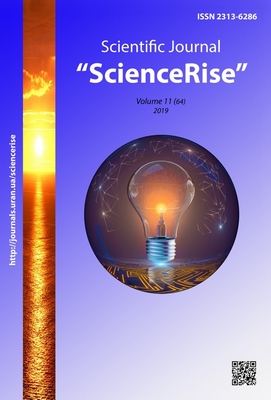Application of the Bjerrum model to pure water electric conductivity
DOI:
https://doi.org/10.15587/2313-8416.2019.188649Keywords:
water electrical conductivity, ionization constant of water, Bjerrum model, activation energy, pH measurementAbstract
An alternative mechanism of electrical conductivity in water is considered. Calculations of activation energies for flow and ionization show their proportionality. Therefore, it is assumed that during the water ionization, not intramolecular forces are involved, but intermolecular and electrical conductivity of water is associated with the appearance in it of L and D defects in hydrogen bonds between water molecules considered in the Bjerrum model for ice
References
Bjerrum, N. (1952). Structure and Properties of Ice. Science, 115 (2989), 385–390. doi: http://doi.org/10.1126/science.115.2989.385
Antonchenko, V. Ia., Davydov, A. S., Ilin, V. V. (1991). Osnovy fiziki vody. Kyiv: Nauk. Dumka, 672.
Eizenberg, D., Kautsman, V. (1975). Struktura i svoistva vody. Leningrad: Gidrometeoizdat, 280.
Antonchenko, V. Ya., Bulavin, L. A., Ilin, V. V. et. al. (2012). Modeliuvannia kharakterystyk vodnykh system. Ukrainskyi fizychnyi zhurnal, 2, 100–175.
Bersuker, I. B. (1987). Effekt Iana – Tellera i vibronnye vzaimodeistviia v sovremennoi khimii. Moscow: Nauka, 344.
Malafaev, N. T. (2011). About interactions and dynamics of molecules in pure water. Eastern-European Journal of Enterprise Technologies, 4 (8 (52)). С. 48–58. Available at: http://journals.uran.ua/eejet/article/view/1465/1363
Gleston, S., Leidler, K., Eiring, G. (1948). Teoriia absoliutnykh skorostei reaktsii. Moscow: Izd-vo inostr. lit-ry, 584.
Afanasev, V. N., Mershchikova, E. IU. (1987). Vzaimosviaz mezhdu kharakteristikami viazkogo techeniia i obemnymi svoistvami zhidkikh sistem. Zhurnal strukturnoi khimii, 61 (1), 232–235.
Rivkin, S. A., Aleksandrov, A. A. (1980). Teplofizicheskie svoistva vody i vodianogo para. Moscow: Energiia, 422.
Malafaiev, M. T., Vorontsova, Zh. V. (2011). Klastery u vodi. Visnyk NTU «KhPI». Novi rishennia v suchasnykh tekhnolohiiakh, 43, 3–7.
Tokushima, T., Harada, Y., Takahashi, O., Senba, Y., Ohashi, H., Pettersson, L. G. M. et. al. (2008). High resolution X-ray emission spectroscopy of liquid water: The observation of two structural motis. Chemical Physics Letters, 460 (4-6), 387–400. doi: http://doi.org/10.1016/j.cplett.2008.04.077
Gonorovskii, I. T., Nazarenko, Iu. P., Nekriach, E. F. (1987). Kratkii spravochnik khimika. Kyiv: Nauk. Dumka, 830.
Revised Release on the Ionization Constant of H2O. Available at: http://www.iapws.org/relguide/Ionization.pdf
Downloads
Published
Issue
Section
License
Copyright (c) 2019 Nikolay Malafayev

This work is licensed under a Creative Commons Attribution 4.0 International License.
Our journal abides by the Creative Commons CC BY copyright rights and permissions for open access journals.
Authors, who are published in this journal, agree to the following conditions:
1. The authors reserve the right to authorship of the work and pass the first publication right of this work to the journal under the terms of a Creative Commons CC BY, which allows others to freely distribute the published research with the obligatory reference to the authors of the original work and the first publication of the work in this journal.
2. The authors have the right to conclude separate supplement agreements that relate to non-exclusive work distribution in the form in which it has been published by the journal (for example, to upload the work to the online storage of the journal or publish it as part of a monograph), provided that the reference to the first publication of the work in this journal is included.

